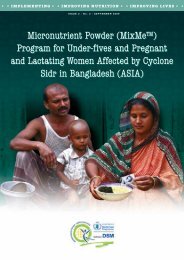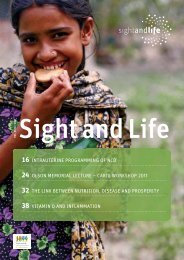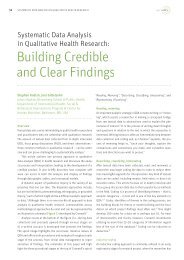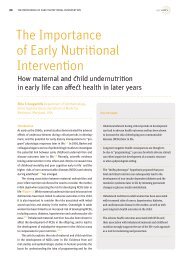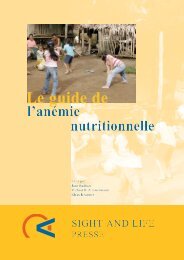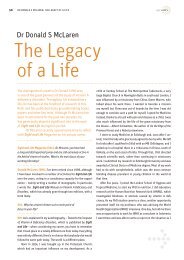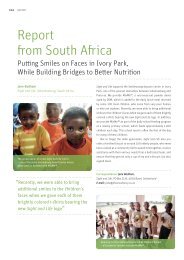Newsletter 02 2006.pdf - Sight and Life
Newsletter 02 2006.pdf - Sight and Life
Newsletter 02 2006.pdf - Sight and Life
Create successful ePaper yourself
Turn your PDF publications into a flip-book with our unique Google optimized e-Paper software.
NEWSLETTER 2/2006<br />
17<br />
SIGHT AND LIFE<br />
Conclusions<br />
Advances in underst<strong>and</strong>ing basic<br />
chemistry <strong>and</strong> functions of<br />
retinoids <strong>and</strong> carotenoids have<br />
been remarkable over the past<br />
four decades. This has paralleled<br />
progress in programs to control<br />
vitamin A deficiency through<br />
medical (supplement distribution)<br />
<strong>and</strong> market-based (food fortification)<br />
approaches. Progress has<br />
also occurred in public health<br />
programs to control immunilizable<br />
infectious diseases that drain<br />
body nutrient reserves, although<br />
there remain an estimated 1.1<br />
billion people without safe water.<br />
Whereas little attention was given<br />
to food-based approaches until<br />
recently, the future is promising<br />
due to breakthroughs that have<br />
occurred <strong>and</strong> are on the horizon<br />
for increasing carotenoids <strong>and</strong><br />
other micronutrient densities in<br />
staple crops eaten by the poor<br />
<strong>and</strong> in improving other agronomic<br />
characteristics that enhance<br />
yields through biofortification. For<br />
carotenoid chemists <strong>and</strong> program<br />
enthusiasts, the research opportunities<br />
are multiple to demonstrate,<br />
for example, bioavailability,<br />
cooking <strong>and</strong> preservation<br />
stability, acceptability, economic<br />
gains <strong>and</strong> biological effectiveness<br />
of these crops in contributing to<br />
control of micronutrient deficiencies,<br />
especially among the poor.<br />
References<br />
1. Proceedings of Symposium on Vitamin A<br />
<strong>and</strong> Metabolism, Bürgenstock, Switzerl<strong>and</strong>,<br />
May, 1960. Vitamins <strong>and</strong> Hormones<br />
18: 289, 1960. (Cited by Roels OA. The<br />
fifth decade of vitamin A research. Am J<br />
Clin Nutr 22:903–7, 1969)<br />
2. Wolf G (1978). A historical note on the<br />
mode of administration of vitamin A for<br />
the cure of night blindness. J Clin Nutr<br />
31:290–2.<br />
3. McCollum EV & Davis M (1913). The necessity<br />
of certain lipids in the diet during<br />
growth. J Biol Chem 15:167–75.<br />
4. Osborne TB & Mendel LB (1913). The relation<br />
of growth to the chemical constituents<br />
of the diet. J Biol Chem 15:311–26.<br />
5. Steenbock H (1919). White corn vs yellow<br />
corn <strong>and</strong> a probable relationship between<br />
the fat soluble vitamins <strong>and</strong> yellow plant<br />
pigments. Science 50: 352.<br />
6. Karrer P, Morf R, & Schöp K (1931). Helv<br />
Chim Acta 14: 1431–6.<br />
7. Wald G (1939). The porphyropsin visual<br />
system. J. General Physiology 22:775–<br />
794.<br />
8. Wolf G (2001). The discovery of the visual<br />
function of vitamin A. J Nutr 131:1647–<br />
1650.<br />
9. Dowling JE & Wald G (1960). The biological<br />
function of vitamin A acid. Proc.<br />
National Acad. Sci 56:587–608.<br />
10. Stephenson M, Clark AB (1920). XLII. A<br />
contribution to the study of keratomalacia<br />
among rats. Biochem J 14: 5<strong>02</strong>–521.<br />
11. Roels OA (1968). The fifth decade of<br />
vitamin A research. Am J Clin Nutr<br />
22:903–907.<br />
12. Bessey OA, Lowry OH, Brock MJ & Lopez<br />
JA (1946). The determination of vitamin A<br />
<strong>and</strong> carotene in small quantities of blood<br />
serum. J Biol Chem 1:177–187l.<br />
13. Neeld JB & Pearson WN (1963). Macro<strong>and</strong><br />
micromethods for the determination<br />
of serum vitamin A using trifluoroacetic<br />
acid. J Nutr 70: 454–462.<br />
14. Carr FH & Price EA (1926). Colour reactions<br />
attributed to vitamin A. Biochem J<br />
20:497–501.<br />
15. Sebrell W H, Jr (1959). Program of the<br />
Columbia University Institute of Nutrition<br />
Sciences. J Am Med Assoc 170:<br />
1928–9.<br />
16. Mason JB, Lotfi M, Dalmiya N, et al.<br />
(2001). The Micronutrient Report. Micronutrient<br />
Initiative, Ottawa, Ontario,<br />
Canada.<br />
17. WHO (1995). Global Prevalence of Vitamin<br />
A Deficiency. MDIS Working Paper<br />
#2, World Health Organization, Geneva,<br />
Switzerl<strong>and</strong>.<br />
18. Micronutrient Initiative/UNICEF (2005).<br />
Vitamin/Mineral Deficiency. A Global<br />
Progress Report.<br />
19. West KP, Jr. Katz J, Khatry SK, LeClerq<br />
SC, Pradhan EK, Shrestha SR, Connor<br />
PB, Dali SM, Parul C, Pokhrel RP, Sommer<br />
A on behalf of the NNIPS-2 Study<br />
Group (1999). Double blind, cluster r<strong>and</strong>omized<br />
trial of low dose supplementation<br />
with vitamin A or β-carotene on mortality<br />
related to pregnancy in Nepal. Brit Med<br />
J 318:570–5.<br />
20. Furr HC (2004). Analysis of retinoids <strong>and</strong><br />
carotenoids: problems resolved <strong>and</strong> unsolved.<br />
J Nutr 134:281S–285S.<br />
21. Congdon N, Sommer A, Severns M. et al.<br />
(1995). Pupillary <strong>and</strong> visual thresholds in<br />
young children as an indicator of population<br />
vitamin A status. Am J Clin Nutr<br />
61:1076–82.<br />
22. Craft NE (2001). Innovative approaches to<br />
vitamin A assessment. J Nutr 131:1626S–<br />
1630S.<br />
23. Haskell MJ, Mazumder RN, Peerson JM,<br />
Jones AD, Wahed MA, Mahalanabis D &<br />
Brown KH (1999). Use of the deuteratedretinol-dilution<br />
technique to assess totalbody<br />
vitamin A stores of adult volunteers<br />
consuming different amounts of vitamin<br />
A. Am J Clin Nutr 70:874–80.<br />
24. Tang G, Qin J, Dolnikowski G, Russell R,<br />
& Grusak MA (2005). Spinach or carrots<br />
can supply significant amounts of vitamin<br />
A as assessed by feeding with intrinsically<br />
deuterated vegetables. Am J Clin Nutr<br />
82:821–8.<br />
25. Olson JA & Hayaishi O (1965). The<br />
enzymatic cleavage of β-carotene into<br />
vitamin A by soluble enzymes of rat liver<br />
<strong>and</strong> intestine. Proc Natl Acad Sci, US<br />
54:1364.<br />
26. Goodman DS & Huang HS (1965). Biosynthesis<br />
of vitamin A with rat intestinal<br />
enzymes. Science 149: 879.<br />
27. Goodman DS & Blaner WS (1984). Biosynthesis,<br />
absorption <strong>and</strong> hepatic metabolism<br />
of retinol. In: The Retinoids, Vol<br />
2. Eds: Sporn MB, Roberts AB & Goodman<br />
DS, pp. 2–39. New York: Academic<br />
Press, Inc.,<br />
28. Goodman DS, (1984). Plasma retinolbinding<br />
protein. In: The Retinoids, Vol. 2.<br />
Eds: Sporn MB, Roberts AB & Goodman<br />
DS. pp. 42–88. New York: Academic<br />
Press, Inc.<br />
29. Loerch J, Underwood B & Lewis K (1979).<br />
Response of plasma levels of vitamin A<br />
to a dose of vitamin A as an indicator of<br />
hepatic vitamin A reserves in rats. J Nutr<br />
109:778–86.<br />
30. Tanumihardjo SA, Furr HC, Erdman JW,<br />
Jr & Olson JA (1990) Use of the modified<br />
relative dose response (MRDR) assay in<br />
rats <strong>and</strong> its application to humans for the<br />
measurement of vitamin A status. Eur J<br />
Clin Nutr 44:219–24.<br />
31. Oomen HAPC, McLaren DS, Escapini H<br />
(1964). Epidemiology <strong>and</strong> public health<br />
aspects of hypovitaminosis A. A global<br />
survey on xerophthalmia. Trop Geograph<br />
Med 16:271–315.<br />
32. McCormick AM, Napoli JL & DeLuca<br />
HF (1978). High-pressure liquid chromatographic<br />
resolution of vitamin A<br />
compounds. Anal Biochem 86:25–33.<br />
33. Roberts AB, Nichols MD, Frolik CA,<br />
Newton DL & Sporn MB (1978). Assay of<br />
retinoids in biological samples by reversephase<br />
high-pressure liquid chromatography.<br />
Cancer Res 38:3327–32.<br />
34. Report of a Joint WHO/USAID meeting<br />
(1976). Vitamin A deficiency <strong>and</strong> xerophthalmia.<br />
Tech Rept Ser 590. World Health<br />
Org., Geneva.<br />
35. Underwood B (2004). Vitamin A deficiency<br />
disorders: International efforts to<br />
control a preventable “pox”. J Nutr 134:<br />
231S–236S.<br />
36. McLaren DS (1987). A decade of achievement:<br />
The International Vitamin A Consultative<br />
Group (IVACG) 1975–1985. International<br />
<strong>Life</strong> Science Institute-Nutrition<br />
Foundation, Washington, D.C.<br />
37. WHO/UNICEF/USAID/Helen Keller International/IVACG<br />
(1982). Control of vitamin<br />
A deficiency <strong>and</strong> xerophthalmia. Tech<br />
Rept Ser 672, World Health Organization,<br />
Geneva.<br />
38. Chambon P (1996). A decade of molecular<br />
biology of retinoic acid receptors.<br />
FASEB J 10:940–54.<br />
39. Sommer A (1982). Nutritional Blindness.<br />
New York: Oxford University Press, Inc.<br />
40. Sommer A, Tarwotjo L, Djunadi E, West<br />
KP, Loeden AA, Tilden R, Mele L & Aced<br />
study group (1986). Impact of vitamin A<br />
supplementation on childhood mortality.<br />
A r<strong>and</strong>omized controlled community trial.<br />
Lancet 327:1169–73.<br />
41. Sommer A & West KP, Jr (1996). Vitamin<br />
A Deficiency Health, Survival, <strong>and</strong> Vision.<br />
New York: Oxford University Press, Inc.,<br />
pp 438.<br />
42. West KP, Jr, Pokhrel RP, Katz J, LeClercq<br />
SC, Khatry SK, Shrestha SR, Pradhan<br />
EK, Tielsch JM, P<strong>and</strong>ey MR, Sommer A<br />
(1991). Efficacy of vitamin A in reducing<br />
preschool child mortality in Nepal. Lancet<br />
338:67–71.<br />
43. Ghana Vast Study Team (1993). Vitamin



